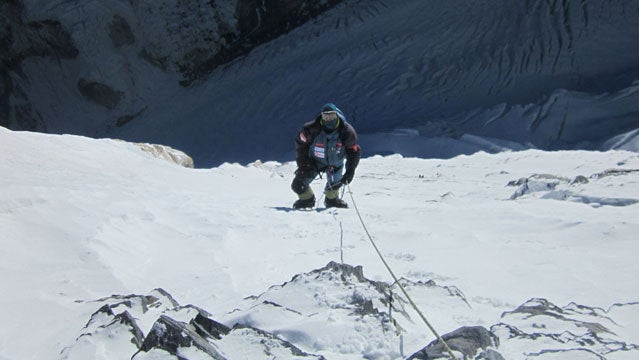For , climbing the Everest Trilogy was a dream, not a plan. Every climber who attempts Everest knows these three Himalayan giants well. They define the boarders of the Western Cwm and are never out of sight.
The Triple
In pictures.
In 2009, the British climbing guide plotted an expedition where he would leave Everest Base Camp at the foot of the Khumbu Icefall to climb Nuptse (25,791 feet), then Everest (29,035 feet), and finally Lhotse, the world’s 4th highest peak at 27,940 feet. But the lack of interest from sponsors, plus a full time job leading clients on Everest, stalled his plan.
But early last month, already at Everest Base Camp, Cool’s sole client had to back out for personal reasons. When he learned that another team was climbing Nuptse and would put up ropes, the dream came into reach—the Khumbu Triple Crown.
Cool, 39, from Gloucestershire, is no greenhorn. He took up climbing while earning a BSc in Geological Sciences at the University of Leeds. His CV is rich with first ascents, and difficult climbs. He was nominated for mountaineering’s Oscar, the for his climb on Annapurna III.
Cool knows Everest. He has a perfect record on Everest, reaching the summit on each of his ten attempts. He made the first cell phone call from the summit in 2011. He found fame throughout the UK in 2012 for taking one of the Olympic Gold medals awarded to members of the 1922 British Everest expedition to the summit. (The medal was for Alpinism, a now defunct category.)
During the closing ceremony of the first Winter Olympics, held at Chamonix in 1924, Edward Lisle Strutt, the expedition’s deputy leader, pledged to take the gold medal to the summit. They did not reach the summit in 1922, stopping at 8,230 meters, but set a new altitude record. That pledge was lost in history, but when Cool got the opportunity to finish the job, he became a national hero.
Cool’s climbing partner would be Dorje Gylgen. They had climbed together since first meeting on Everest in 2007. Young at age 28, Gylgen was a trusted partner, strong and as determined as Cool, with a matching 10 successful Everest summits.
Cool knew Everest and Lhotse would be attainable, but Nuptse was more of an unknown. Nuptse is the lowest of the three and rarely climbed. It is considered quite technically difficult and the South Pillar attracts the world’s best climbers. The main summit was first climbed on May 16, 1961 by a British expedition.
This year, Himalayan Experience’s Russell Brice had his sights set on the summit and put up his best team of Sherpas to fix ropes to the summit. A small, all-women team of 4 were to climb the route. Cool approached Brice and talked him into sharing the ropes.
Cool left Base Camp on May 15 at 5:00 a.m. He had previously stocked the upper camps with supplies, and he had no client, so he was free to go as fast or as long as he could. “With no client to look after, I was free to climb for fun, for selfish reasons,” Cool said. “It was an opportunity to open my wings, climb with Dorge and enjoy it for what it is. It was great. Sometimes we lose that sense of fun in climbing when we are working to help clients reach their dreams and bring them home safely.”
Gylgen had spent the day ferrying loads to the South Col and did not join Cool on Nuptse.
Cool left Camp III on Nuptse at 2:00 a.m. on May 16. He said it was a difficult climb, longer and much more technical than Everest or Lhotse. Climbing with 29-year-old , he broke the deep snow-bound trail about an hour ahead of the Himex team.
The summit of Nuptse is known for being difficult, with loose, rotten snow and large mushrooms of wind-driven cornices that can turn into death traps.
Cool and Txikon reached the loose snow just below the summit with one of the Himex Sherpas, Nima. Tethered to a piece of line cut off by Nima, Cool, climbed onto the mushroom of snow and gingerly touched the very top.
“My crampons were slipping on the crumbling snow, I was struggling to maintain my stance. With both arms outstretched, my mind went to my family, my wife and children—and for a moment, I was afraid.”
Ellen Miller, climbing with the Himex team described it this way:
“The shapes of snow mushrooms at the top were indeed rotten and fragile … and very much like swiss cheese. We got to the summit of the mountain, top of rocks and Earth, but the wind-formed snow shapes were slightly above. Our Sherpas and guide thought it was too dangerous and foolish to climb on top of those formations as the snow was cracking and crumbling under our feet, and if they had broken, we could have plunged off of the mountain … thus we stood on the last piece of solid snow and ‘touched’ those snow waves.”
Both Miller and Cool give immense credit to the Sherpas who fixed the route. “With all the controversy around western climbers and the Sherpas this year,” Cool says, “Seeing the Himex Sherpas work so hard to set the line, increased my considerable admiration for them.”
With Nuptse complete, Cool now saw his dream come into focus. He immediately went from the summit of Nuptse to Camp II in the Western Cwm, arriving at 5:45 p.m. the same day he summited Nuptse.
On May 17, he and Gylgen climbed to Camp III on the Lhotse Face. Then, on May 18, to the South Col. They left the Col at 8:00 p.m. on May 18, reaching the summit of Everest at 1:45 p.m. on May 19.
Standing in the cold and dark, Cool later said on his Facebook page, “Disappointment of being early and not seeing sun rise made good with privilege of sitting alone in absolute silence with my friend just as i’ve always think Hilary and Tenzing did. Dorje and I laughed at the stupidity of our small head-torches beaming into nothing.”
They descended quickly and avoided any other climbers. The Everest climb was almost routine for the seasoned guide. Back at the South Col at 4:00 a.m., they rested and soon left for the final leg of the Triple Crown.
Leaving the South Col at 10:30 a.m., they climbed down the Geneva Spur. Cool began to think about what he was doing. He was having fun. It was almost a race between him and Gylgen, a contest of strength and willpower.
They arrived high on the Lhotse Face on the afternoon of May 20. Gylgen went on to the high camp while Cool stopped at the lower one. But then something unexpected occurred.
Hearing moaning from a nearby tent, Cool went to investigate. He found 58-year-old Taiwanese climber Xiaoshi Li in a tent. He was with a Sherpa who was also impaired.
Li had summited Lhotse on May 16 but had quickly begun to show symptoms of HACE. Ben Jones, a guide from Alpine Ascents International had spent the previous day with Li. He had administered the steroid dexamethasone, but a long-line helicopter rescue had failed.
Now Li was alone in his tent as his Sherpa prepared to descend to Camp III, fighting for his own life.
Consulting with the Himalayan Rescue Association (HRA) at Base Camp, Cool began a night-long vigil. He gave him more dex and eventually began CPR as Li’s pulse weakened.
Thoughts of climbing Lhotse and the Trilogy slipped farther and farther back in his mind.
Li passed in and out of consciousness throughout the night, uttering faint groans and unintelligible words to Cool.
At 4:00 a.m., May 21, Li’s heart stopped. Cool frantically applied cardiac massage under the direction of the HRA. After two and half more hours, he stopped, devastated.
Sitting back in his tent, Cool had lost all motivation to continue his climb. He felt the death had been avoidable, that Li’s logistics company had let him down.
Cool was ready to quit. But fellow guide and friend Mike Roberts, climbing on his own that same day, stuck his head in the tent and said simply, “It is time to go.” It was 8:00 a.m. and the weather was perfect.
The two mountain guides joined forces and caught up with the Sherpas at high camp and left for the summit at 9:15 that morning. Cool had regained his motivation and began to climb.
Lhotse is known as a dangerous mountain, with the final push to the summit through a narrow, rock-filled gully. Another climber above them kept knocking rocks onto their heads.
Cool described the final push as “Unpleasant. Nothing like I have ever seen in the Himalaya, with rocks falling all around. But I throughly enjoyed climbing in the couloir, so narrow at times that you could touch both sides with your outstretched arms. It was the difference in style of climbing, unlike the large, open slopes that many 8000-meter peaks are defined by—it was more like climbs found in Chamonix or even Scotland.”
The four climbers reached the summit at 1:00 p.m. on May 20, a short 35 hours after summiting Everest. It had taken them 3 hours and 50 minutes from Lhotse’s Camp IV. The overcast skies kept him from what he says is the reward for his climbs—a nice view.
Cool is ecstatic. His only regret was that Gylgen was not on the summit of Nuptse with him.
In looking at the Everest season, he is pleased that there was not a repeat of the 2012 difficulties with long lines and large crowds. He cites last year’s two short summit days, compared to nine this year, as the reason for a more orderly season.
When asked about solutions on the overcrowding on Everest, he speaks of guides and operators taking more responsibility for their clients. He believes clients need to be better informed about the dangers of low-cost operators. He does not believe raising the permit fees will address the problem of inexperienced climbers, or crowds.
In a surprise move, Cool says he might skip Everest next year. Instead, he is considering a new route on Kanchenjunga, the world’s third highest mountain.
But the emotion in his voice betrays his excitement for a new project, one which he’s keeping under wraps. He describes it as something he has wanted to do for a long time in an area currently not open for climbing. That is all he would say. I guess we will have to wait and see.


